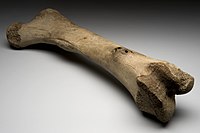
Photo from wikipedia
OBJECTIVES To examine periprosthetic bone remodeling among the recipients of two types of lower-limb osseointegrated systems, the Integral Leg Prosthesis (ILP) and the Osseointegration Prosthetic Limb Type-A (OPL), over a… Click to show full abstract
OBJECTIVES To examine periprosthetic bone remodeling among the recipients of two types of lower-limb osseointegrated systems, the Integral Leg Prosthesis (ILP) and the Osseointegration Prosthetic Limb Type-A (OPL), over a > 24-month period. DESIGN Retrospective cohort study. SETTING Private hospital, with a specialized osseointegration unit. PATIENTS Twenty-eight patients with transfemoral lower limb amputations were fitted with osseointegrated systems. Of these patients, 15 received the ILP and 13 the OPL osseointegrated implant. INTERVENTION Radiographic measurements were taken at baseline (0.4 ± 0.5 years) and at follow-up (3.0 ± 0.8 years) following the osseointegration procedure. MAIN OUTCOME MEASUREMENTS Radiographic bone density, longitudinal bone coverage, and bone width outcomes were measured in inverse 'Gruen Zones'. Bone remodeling was evaluated by comparing changes between baseline and follow-up measurements. RESULTS Radiographic bone density decreased in all zones among both ILP and OPL groups. Cortical bone thickness increased among the OPL group in Zones 3 (p < 0.05) and 5 (p < 0.05). Distal bone coverage of the ILP implant decreased by 2.3% (p < 0.01 ) and 4.1% (p < 0.05) of the total implant length on the medial and lateral sides respectively. CONCLUSIONS Decreased bone density with increased periprosthetic cortical thickness suggests a change in the bone architecture for the OPL group. The findings of this study raise concerns for the long-term success of the ILP implant. Radiographic analysis of X-rays appears to be a useful tool for clinicians to evaluate bone remodeling around osseointegrated prosthesis. LEVEL OF EVIDENCE Prognostic Level II.
Journal Title: Journal of Orthopaedic Trauma
Year Published: 2019
Link to full text (if available)
Share on Social Media: Sign Up to like & get
recommendations!